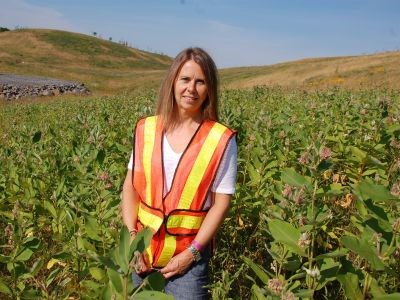The mountainous slag piles at nickel miner Vale in Sudbury are becoming a favourite landing spot for one of nature’s most threatened species.
A milkweed patch has also been established at the base of the waste industrial material on the periphery of the company’s Copper Cliff smelter complex in an effort to attract and boost the declining monarch butterfly population.
Long considered a nuisance plant, milkweed has been disappearing fast in recent decades due to the use of chemical herbicides and deforestation. The plant is crucial to the survival of the monarch butterfly on its journey between Mexico and Canada. It’s the only suitable plant for monarch to lay their eggs and is also a main food source of monarch caterpillars.
Lisa Lanteigne, Vale’s manager of environment, soil and water, first noticed the hardy perennial growing naturally at her Manitoulin Island cottage.
“I fell in love with the plant at camp and you hear about the plight of the monarch and how they’re reduced in numbers so significantly over the last 10 years, the numbers dropping from 550 million (in 2004) to 33 million (in 2013).”
Farmers along the monarch’s 4,800-kilometre migratory flightpath have been largely eradicating milkweed from their fields of crops.
It’s resulted in a grassroots call to action across the U.S. for mass plantings of milkweed, a movement joined by the Obama administration in launching a plan last spring to increase the number of pollinators and monarchs by seeding habitat along the flyway between Texas and Minnesota.
“We’ve been trying to plant them over the last several years and seeds are hard to come by, said Lanteigne. “It’s just not something that most people would want to plant in their garden.”
Last year, 2,000 common milkweed plants were special-ordered from a southern Ontario nursery and planted in a landscaped pond area in front of Vale’s engineering building in Copper Cliff.
Pollinators such as birds, bees and other insects have airlifted the seeds into patches along Big Nickel Road to the northeast. Eventually, the environmental team will establish plots further along the slag piles and other areas of the company property.
“The idea now is to collect seeds from our own plants and incorporate it into our seed mix with other wild flowers and trying to expand the milkweed habitat for the butterflies.”
The company has partnered with a local group, Save the Butterflies, to create milkweed habitat in neighbourhoods around Sudbury by germinating the seeds at Vale’s greenhouse in Copper Cliff.
Earlier in the summer, some 650 milkweed plants were saved from being bulldozed at a festival site near Sudbury and brought back to the greenhouse where schoolkids and community volunteers have potted them.
Lanteigne said planting milkweed doesn’t hold any great benefits for slag pile bank stabilization or water drainage, it’s just a good corporate social responsibility project that complements the company’s other environmental programming.
Sudbury and the nickel miner have garnered international attention for its regreening and beautification efforts across the scarred Sudbury landscape. The company has established a nearby apiary – a honeybee colony – on the slagpile slope and also rears trout in its greenhouse to restock area lakes and rivers.
The company began a campaign of greening the perimeter of the slag piles in 2007. Bulldozers graded and contoured the slopes with clay placed to promote the growth of vegetation. The entire area was then hydro-seeded. Once grass took root, mature trees were planted at the top and company-grown pine seedlings established along the banks.
Lanteigne said they don’t plan to manipulate the area too much but rather let the pollinators do their work.
“We’ll let it come in naturally over time,” said Lanteigne, “and not do too much of a monoculture. The aim is biodiversity.”




